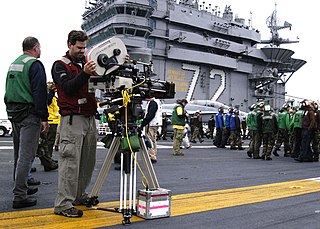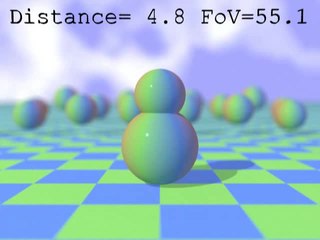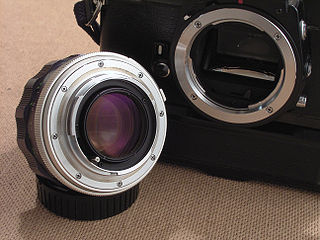Related Research Articles

In cinematography, a tracking shot is any shot where the camera follows backward, forward or moves alongside the subject being recorded. Mostly the camera’s position is parallel to the character, creating a sideway motion, tracking the character. Tracking shots differ in motion from dolly shots, where the camera follows behind or before the character resulting in either an inward or an outward movement. Often the camera is mounted on a camera dolly which rides on rails similar to a railroad track; in this case, the shot is referred to as a dolly shot. A handheld steadycam or gimbal may also be used for smaller scale productions. The camera is then pushed along the track while the scene is being filmed, or moved manually when using a handheld rig. The effect can be used to create a sense of movement, to follow a character or object, or a sense of immersion to draw the viewer into the action.

Chroma key compositing, or chroma keying, is a visual-effects and post-production technique for compositing (layering) two or more images or video streams together based on color hues. The technique has been used in many fields to remove a background from the subject of a photo or video – particularly the newscasting, motion picture, and video game industries. A color range in the foreground footage is made transparent, allowing separately filmed background footage or a static image to be inserted into the scene. The chroma keying technique is commonly used in video production and post-production. This technique is also referred to as color keying, color separation overlay, or by various terms for specific colour-related variants such as green screen or blue screen; chroma keying can be done with backgrounds of any color that are uniform and distinct, but green and blue backgrounds are more commonly used because they differ most distinctly in hue from any human skin colour. No part of the subject being filmed or photographed may duplicate the color used as the backing, or the part may be erroneously identified as part of the backing.

The cinematographer or director of photography is the person responsible for the recording of a film, television production, music video or other live-action piece. The cinematographer is the chief of the camera and light crews working on such projects. They would normally be responsible for making artistic and technical decisions related to the image and for selecting the camera, film stock, lenses, filters, etc. The study and practice of this field are referred to as cinematography.
The focal length of an optical system is a measure of how strongly the system converges or diverges light; it is the inverse of the system's optical power. A positive focal length indicates that a system converges light, while a negative focal length indicates that the system diverges light. A system with a shorter focal length bends the rays more sharply, bringing them to a focus in a shorter distance or diverging them more quickly. For the special case of a thin lens in air, a positive focal length is the distance over which initially collimated (parallel) rays are brought to a focus, or alternatively a negative focal length indicates how far in front of the lens a point source must be located to form a collimated beam. For more general optical systems, the focal length has no intuitive meaning; it is simply the inverse of the system's optical power.

In photography, shutter speed or exposure time is the length of time that the film or digital sensor inside the camera is exposed to light when taking a photograph. The amount of light that reaches the film or image sensor is proportional to the exposure time. 1⁄500 of a second will let half as much light in as 1⁄250.

A dolly zoom is an in-camera effect that appears to undermine normal visual perception.

Cinematography is the art of motion picture photography.

Slow motion is an effect in film-making whereby time appears to be slowed down. It was invented by the Austrian priest August Musger in the early 20th century. This can be accomplished through the use of high-speed cameras and then playing the footage produced by such cameras at a normal rate like 30 fps, or in post production through the use of software.
Film look is a process in which video is altered in overall appearance to appear to have been shot on film stock. The process is usually electronic, although filmizing can sometimes occur as an unintentional by-product of some optical techniques, such as telerecording. The process has the opposite result to VidFIRE, used to restore a video look to telerecorded video.

Compositing is the process or technique of combining visual elements from separate sources into single images, often to create the illusion that all those elements are parts of the same scene. Live-action shooting for compositing is variously called "chroma key", "blue screen", "green screen" and other names. Today, most compositing is achieved through digital image manipulation. Pre-digital compositing techniques, however, go back as far as the trick films of Georges Méliès in the late 19th century, and some are still in use.

Day for night is a set of cinematic techniques used to simulate a night scene while filming in daylight. It is often employed when it is too difficult or expensive to actually film during nighttime. Because both film stocks and digital image sensors lack the sensitivity of the human eye in low light conditions, night scenes recorded in natural light, with or without moonlight, may be underexposed to the point where little or nothing is visible. This problem can be avoided by using daylight to substitute for darkness. When shooting day for night, the scene is typically underexposed in-camera or darkened during post-production, with a blue tint added. Additional effects are often used to heighten the impression of night.

A lens mount is an interface – mechanical and often also electrical – between a photographic camera body and a lens. It is a feature of camera systems where the body allows interchangeable lenses, most usually the rangefinder camera, single lens reflex type, single lens mirrorless type or any movie camera of 16 mm or higher gauge. Lens mounts are also used to connect optical components in instrumentation that may not involve a camera, such as the modular components used in optical laboratory prototyping which join via C-mount or T-mount elements.

Time-lapse photography is a technique in which the frequency at which film frames are captured is much lower than the frequency used to view the sequence. When played at normal speed, time appears to be moving faster and thus lapsing. For example, an image of a scene may be captured at 1 frame per second but then played back at 30 frames per second; the result is an apparent 30 times speed increase.

Digital cinematography is the process of capturing (recording) a motion picture using digital image sensors rather than through film stock. As digital technology has improved in recent years, this practice has become dominant. Since the 2000s, most movies across the world have been captured as well as distributed digitally.

Mattes are used in photography and special effects filmmaking to combine two or more image elements into a single, final image. Usually, mattes are used to combine a foreground image with a background image. In this case, the matte is the background painting. In film and stage, mattes can be physically huge sections of painted canvas, portraying large scenic expanses of landscapes.

A front projection effect is an in-camera visual effects process in film production for combining foreground performance with pre-filmed background footage. In contrast to rear projection, which projects footage onto a screen from behind the performers, front projection projects the pre-filmed material over the performers and onto a highly reflective background surface.

Virtual cinematography is the set of cinematographic techniques performed in a computer graphics environment. It includes a wide variety of subjects like photographing real objects, often with stereo or multi-camera setup, for the purpose of recreating them as three-dimensional objects and algorithms for the automated creation of real and simulated camera angles. Virtual cinematography can be used to shoot scenes from otherwise impossible camera angles, create the photography of animated films, and manipulate the appearance of computer-generated effects.

The over-the-shoulder shot is a camera angle used in film and television, where the camera is placed above the back of the shoulder and head of a subject. This shot is most commonly used to present conversational back and forth between two subjects. With the camera placed behind one character, the shot then frames the sequence from the perspective of that character. The over-the-shoulder shot is then utilised in a shot-reverse-shot sequence where both subject's OTS perspectives are edited consecutively to create a back and forth interplay, capturing dialogue and reactions. This inclusion of the back of the shoulder allows audiences to understand the spatial relationships between two subjects, while still being able to capture a closer shot of each subject’s facial expression. In film and television, the filmmaker or cinematographer’s choice of an OTS shot’s camera height, the use of focus and lenses affect the way audiences interpret subjects and their relationships to others and space.

Anamorphic format is the cinematography technique of shooting a widescreen picture on standard 35 mm film or other visual recording media with a non-widescreen native aspect ratio. It also refers to the projection format in which a distorted image is "stretched" by an anamorphic projection lens to recreate the original aspect ratio on the viewing screen.
In photography and cinematography, headroom or head room is a concept of aesthetic composition that addresses the relative vertical position of the subject within the frame of the image. Headroom refers specifically to the distance between the top of the subject's head and the top of the frame, but the term is sometimes used instead of lead room, nose room or 'looking room' to include the sense of space on both sides of the image. The amount of headroom that is considered aesthetically pleasing is a dynamic quantity; it changes relative to how much of the frame is filled by the subject. Rather than pointing and shooting, one must compose the image to be pleasing. Too much room between a subject's head and the top of frame results in dead space.
References
Citations
- 1 2 3 4 Perisic 2000, p. 92-93.
- ↑ Kaufman, Gil. "Lens Recap: The Story Behind Coldplay's 'The Scientist'". MTV News. Archived from the original on May 3, 2014. Retrieved 2021-05-01.
- ↑ The Beatles - Strawberry Fields Forever, archived from the original on 2021-12-13, retrieved 2021-05-01
- ↑ Mutemath - Typical (Video), archived from the original on 2021-12-13, retrieved 2021-05-01
- ↑ alt-J (∆) Breezeblocks, archived from the original on 2021-12-13, retrieved 2021-05-01
- ↑ The Pharcyde - Drop (Official Music Video), archived from the original on 2021-12-13, retrieved 2021-05-01
- ↑ Williams 2006, p. 91-92.
- 1 2 Bernstein 1994, p. 227.
- ↑ Malkiewicz & Mullen 2009, p. 40.
- ↑ Tomorrow Never Dies 1997, Desmond Llewelyn, James Bond, archived from the original on 2021-12-13, retrieved 2021-05-01
- ↑ Wilkie 1996, p. 68.
- 1 2 Ohanian & Phillips 2000, p. 142.
Sources
- Perisic, Zoran (2000). Visual Effects Cinematography. Focal Press. ISBN 9780240803517.
- Williams, James (2006). Jean Cocteau. Manchester University Press. ISBN 9780719058837.
- Malkiewicz, Kris; Mullen, M. David (2009). Cinematography (Third ed.). Simon and Schuster. ISBN 9781439105627.
- Wilkie, Bernard (1996). Creating Special Effects for TV and Video. Focal Press. ISBN 9780240514741.
- Bernstein, Steven (1994). Film Production. Focal Press. ISBN 0-240-51343-6.
- Ohanian, Thomas; Phillips, Michael (2000). Digital Filmmaking. Focal Press. ISBN 9780240804279.